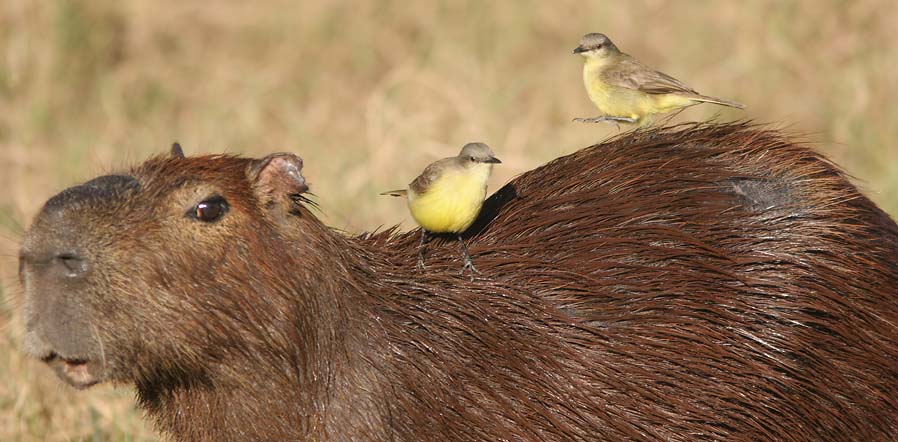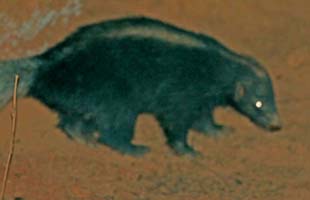| |
|
|
| |
text & photos by Don Roberson
|
|
| |
The world's largest rodent is abundant along rivers and in lakes in the Pantanal, so there was a lot of opportunity to enjoy Capybara Hydochaeris hydrochaeris
(above, right, next two below). Some live in harems dominated by a
large male (below), but others can be found singly (above & right).
They graze near water, and provide convenient perches for birds like
Cattle Tyrant (second below). The nose, ears, and eyes are placed high
on the head, allowed them to swim mostly submerged. They have partially
webbed toes and are very good swimmers.
We encountered another rodent in the Pantanal inside riverine forests — Azara's Agouti Dasyprocta azarae — but it was always at dusk; I didn't manage any photos. |
|
|
|
| |
|
|
| |
|
|
| |
 |
We did not have many mammals in the Atlantic forests; the most often seen was Guianan Squirrel Sciurus aestuans
(left). It behaved (and sounded) very like the tree squirrels in
California, such as Western Gray Squirrel or the introduced Fox
Squirrel.
We also saw another largish rodent, Nutria Myocastor coypus, swimming in small reedy lakes outside the parks on our drive between Intervales and Itatiaia. |
|
|
| |
| Tapirs
are the only extant native New World member of the odd-toed ungulates
(Perissodactyla; Old World examples include zebras and rhinos). Rita
and I had seen Brazilian Tapir Tapirus terrestris
during our 1999 trip to Rio Cristalino, and also in the Pantanal. On
this 2010 trip we saw two, but only at night (one photo'd in spotlight
beam, right). They were feeding in corn stubble before dawn, in a field
outside Emas NP. Presumably they moved into the park during the day for
safety. |
|
|
|
| |
 |
Deer and peccaries are among the even-toed ungulates (Artiodactyla). We had fine views of three species of deer on the trip: Pampas Deer Ozotoceros bezoarticus (left, common in Emas NP); the much smaller Red Brocket Deer Mazama americana (below left, photo'd in the Pantanal); and the very large Marsh Deer Blastocerus dichotomus (below right; that's a Smooth-billed Ani riding on the back). Marcelo saw a Gray Brocket Deer M. gouazoubira while spotlighting, but we never got decent views.
Pampas
Deer reminded us of the Black-tailed Deer in our backyard in Pacific
Grove. Marsh Deer is an endangered species, limited to extensive
swamplands in central South America. It is the largest deer in the
Neotropics. Indeed, it is included among the Pantanal "Big Five:"
Jaguar, Giant Otter, Giant Anteater, Tapir and Marsh Deer. We saw all
"big five" on our trip, although not all were in the Pantanal.
|
|
|
| |
|
|
| |
|
|
| |
 |
Carnivores may be the most impressive of all mammals, and almost none are so wonderful as Giant Otter Pteroneura brasiliensis
(above, left, below). We had three incredible encounters on different
days, on the Rio Claro, Rio Cuiaba, and Rio Piquiri (these photos).
They live in family groups of 8-12, centered around a home burrow. One
could actually smell the location of some burrows as the groups wallow
in urine and feces there to create a pungent smell that deters
predators — these otters are serious carnivores with huge teeth and
sharp claws on their webbed feet. Yet they are so appealing when
engaged in play, or sleeping in the mid-day sun (above). Rita obtained
some very impressive video. |
|
|
| |
|
|
| |
| Night drives and spotlighting found us other carnivores, including Maned Wolf Chrysocyon brachyurus at Emas (no photos) and Striped Hog-nosed Skunk Conepatus semistriatus at Emas (right). Every night drive in the Pantanal had Crab-eating Fox Cerdocyon thous (below left) but only once, in Emas, did we find a Hoary Fox Pseudalopex vetulus
(below right). Hoary Fox is a Brazilian endemic — note its big ears,
long muzzle, huge tail, and pale feet (blackish in Crab-eating Fox). |
|
|
|
| |
|
|
| |
|
|
| |
| Finally, of course, was the raison d'être of the entire trip: Jaguar Panthera onca.
We spent three days on the Rio Cuiaba and tributaries looking for this
great cat, and finally saw one in our 18th hour of effort. Then a
second was encountered just two hours later. We had a female sunning on
a beach on the Rio Piquiri (above) and a huge male walking at the edge
of the forest on the Rio Cuiaba (below). |
|
|
| |
|
|
| |
|
|
| |
|
page created 11 Sep 2010
|
|
© Don Roberson 2010 |
|
|
















